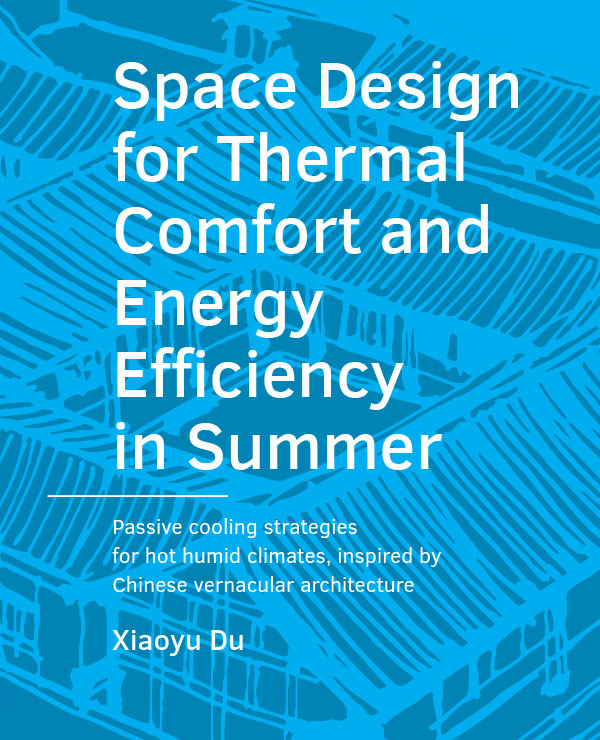Output of part I:
Defining the relationship of spatial design, building microclimate and thermal summer comfort in dwellings
DOI:
https://doi.org/10.7480/abe.2019.10.4161Abstract
In part 1, a literature review was done to summarise and introduce the theoretical background knowledge of thermal comfort and passive cooling technology. The adaptive thermal comfort was explained because it is applicable to a free-running building which is the studied object of this research. The basic theory and design standards of adaptive thermal comfort were reviewed. A brief overview of passive cooling techniques was given. The techniques were then reviewed based on their relationships with urban morphology, building shape, layout, opening and “elements”.
The study started with a Chinese vernacular building (chapter 4) because these always use the passive way to achieve a comfortable living environment under the limitations of technology at that time. Firstly, the spatial design strategies for passive cooling of a Chinese vernacular house were investigated in a field survey. The design of modern rural houses under free-running conditions compared with the Chinese vernacular house. It was found that the modern rural house did not achieve a satisfactory thermal summer environment under free-running conditions, while the vernacular house did. Furthermore, the vernacular house was deeply analysed by field measurements and dynamic thermal simulations. It was found that the particular spatial design of the vernacular house has its own building microclimate, which is important for the occupants’ thermal summer comfort. The concept of building microclimate was identified. In this study, the scale of “building microclimate” refers to a type of microclimate, involving the indoor space and the spaces around the indoor spaces of a particular building. It is the extension of the indoor climate. The spatial scale is smaller than the urban fabric. It rarely covers an area more than several hundred meters wide, but is bigger than an indoor space alone. It is limited to one particular building, whether a small house or a big stadium. The building microclimate is mainly defined by the spatial and the thermo-physical properties. Similar to the influence of urban morphology on urban microclimate, the spatial configuration influences the building microclimate significantly. To have a particular microclimate at the building scale, some key factors of spatial configuration such as spatial diversity, spatial arrangement and boundary conditions between spaces should be identified.
The spatial design of modern house is different from the vernacular house due to the evolution of people’s lifestyle over a long period. Can a modern house have a good building microclimate? To answer this question, the spatial design and thermal environment of a modern house were analysed through field survey and simulation. It was found that a modern house can also have its own microclimate and that the microclimate of this particular building can provide considerable thermal comfort for the occupants in summer under local climate conditions.
Adaptive actions, for example movement, can explain why occupants can achieve thermal comfort in a building microclimate with diverse spaces. To find the relationship between the occupants’ spatial perception and thermal perception, a questionnaire was put forward. It was found that the spatial openness of a particular space significantly affects the occupants’ visual perception, wind speed perception and thermal perception. It was revealed that the occupants’ spatial perception and thermal perception are associated. The strongest correlation is between spatial openness and visual perception and wind speed perception. That means spatial boundary conditions can strongly influence occupants’ comfort perception, and subsequently influence the occupants’ spatial choice and movement in a particular thermal environment, given the opportunity, as Humphreys (1997) pointed out: when people are free to choose their location, it helps if there is plenty of thermal variety, giving them the opportunity to choose the places they like. The fundamental assumption of the adaptive approach is expressed by the adaptive principle: “if a change occurs such as to produce discomfort, people react in ways which tend to restore their comfort”. Nicol et al. (2012) proposed that there are at least five basic types of adaptive actions. One important adaptive action is selecting a different thermal environment. Occupant movement in a particular building microclimate is significant for thermal comfort. Occupants can change their location for different activities. Movement is possible between buildings, between rooms, around rooms, out of the sun and into the breeze, and so on (Nicol et al., 2012).
References
AlAnzi, A., Seo, D., & Krarti, M. (2009). Impact of building shape on thermal performance of office buildings in Kuwait. Energy Conversion and Management, 50(3), 822-828. doi: 10.1016/j.enconman.2008.09.033
Fu, X. (2002). Building energy saving technology in hot summer and cold winter region. Beijing: China Architecture and Building Press.
Hirano, T., Kato, S., Murakami, S., Ikaga, T., & Shiraishi, Y. (2006). A study on a porous residential building model in hot and humid regions: Part 1—the natural ventilation performance and the cooling load reduction effect of the building model. Building and Environment, 41(1), 21-32. doi: 10.1016/j.buildenv.2005.01.018
Humphreys, M. A. (1997). An adaptive approach to thermal comfort criteria. In D. Clements Croome (Ed.), Naturally Ventilated Buildings: Building for the Senses, the Economy and Society. London E and FN Spon.
Naraghi, M. H., & Harant, A. (2013). Configuration of Building Facade Surface for Seasonal Selectiveness of Solar Irradiation-Absorption and Reflection. [Article]. Journal of Solar Energy Engineering-Transactions of the Asme, 135(1). doi: 10.1115/1.4006673
Ratti, C., Raydan, D., & Steemers, K. (2003). Building form and environmental performance: archetypes, analysis and an arid climate. Energy and Buildings, 35(1), 49-59. doi: http://dx.doi.org/10.1016/S0378-7788(02)00079-8
Yi, Y. K., & Malkawi, A. M. (2009). Optimizing building form for energy performance based on hierarchical geometry relation. Automation in Construction, 18(6), 825-833. doi: 10.1016/j.autcon.2009.03.006

